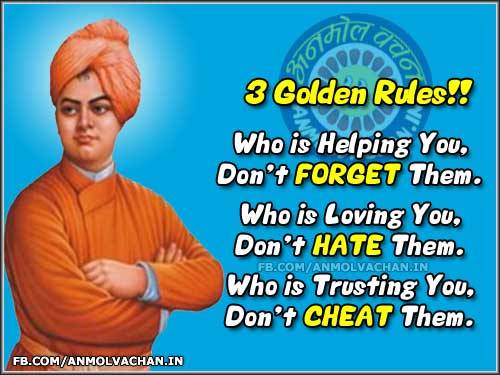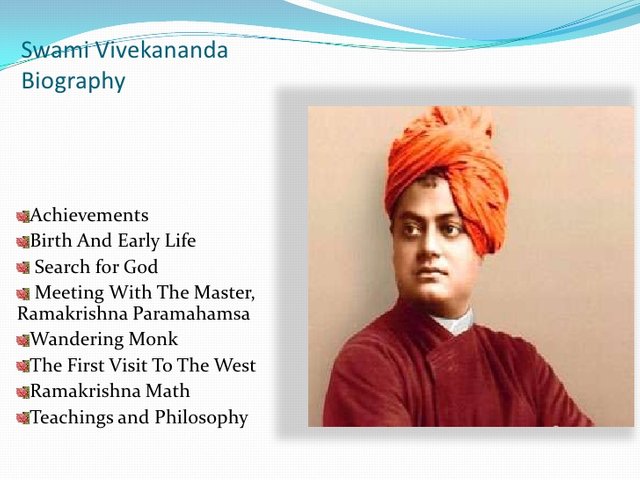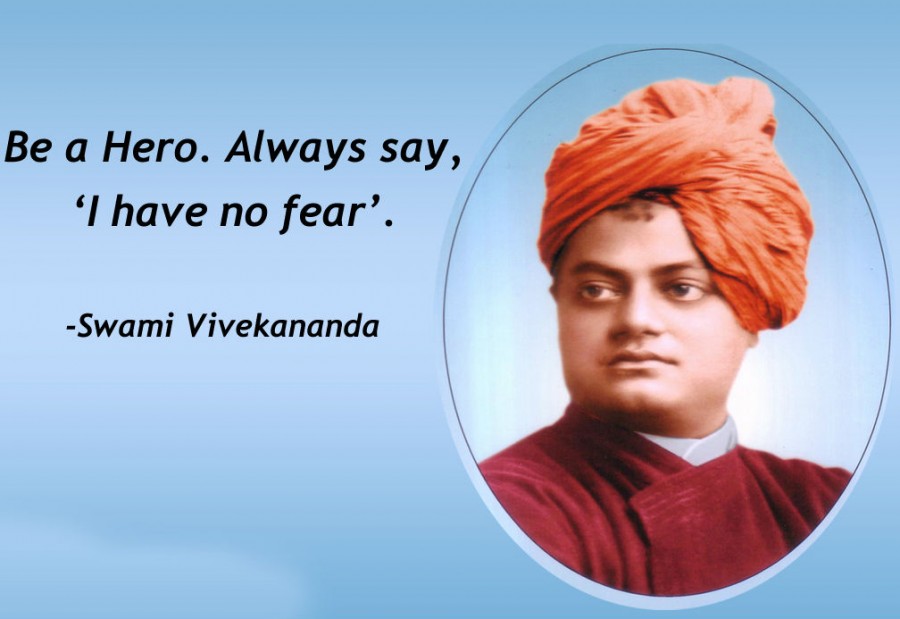Biography of Swami Vivekananda

A monk born in our country [Monk], who achieved fame because of his work in his short life, and not only the country, but also in his foreign countries, his knowledge and intention were considered as iron, such great men were - "Swami Vivekananda".
In the 19th century, the great man who contributed to the education of Indian scholar Ramkrishna Paramahansa and spreading Indian culture and literature to foreign countries were Swami Vivekananda.
He has contributed a great deal to make the place of 'Hindu Dharma' in the whole world and its importance.
Swami Vivekananda Life Introduction:
Literary Work
All the speeches given to Raj Yoga, Karma Yoga, Bhakti Yoga, my Guru, [my Master], Almora to Kolombo, [Lectures].
Other important functions:
Establishment of Vedanta Society in New York, 'Peace Retreat' in California and establishment of Advaita Ashram near Almora in India.
Notable disciples:
Ashokanand, Virajanand, Paramananda, Alasinga Perumal, Abhyananda, sister [Sister] Nivedita, Swami Sadanand.
Death dates:
July 4, 1902
Death place
Belur, West Bengal, India.
Swami Vivekananda did a lot of work for India's spiritual upliftment [Spiritual Enlightenment]. Vedanta Philosophy expanded in the countries of the West. He was the most effective person of Vedanta Philosophy, the most influential spirituality and established the "Ramakrishna Mission" to serve the poor.
They were idols of sacrifice and they dedicated their whole life to the rise of the country and the poor. For this, he always used to be salute. He had filled new zeal and enthusiasm for making progress in the youth of the country. He is known as a patriot saint, so his birthday is celebrated as "National Youth Day".
The family of Narendra:
Narendra was born on 12 January 1863 in the city of Calcutta in the British Raj on the day of Makar Sankranti. He was from a traditional Bengali family and had a total of nine brothers and sisters. His father Vishwanath Dutt was the attorney in the Calcutta High Court, and the mother Bhuvaneshwari Devi was a religious woman. His grandfather was a scholar of Sanskrit and Persian. This kind of religious and educated atmosphere in the house has made such a high personality of Narendra.
Narendra's childhood and related tales:
When Narendra was small, he used to be very mischievous. He was also the best in sports as well as in studies. He studied singing and musical instruments to play music. From an early age, they used to meditate as well.
In his childhood, he used to question the existence of God and about various customs and casteism about casteism and was curious about their right or wrong. From childhood, Narendra had great respect for the Sanyasis in his mind, if a monk or some person had a need for something or a person needed something and if he had been with him, he would give it to him immediately.
Narendrabhai, as good as his childhood, was also naughty. It is confirmed by the fact that his mother used to say a thing about him that he always prayed to Lord Shiva for giving a child and he accepted this prayer and sent it to some ghost [Ghost].
Education initiation of Narendra:
In 1871, when Narendra was 8 years old, his entry was made in the Metropolitan Institution of Ishwar Chandra Vidyasagar and he got this education till 1877. From 1877-1879, the co-family stayed in Raipur and returned to Calcutta in 1879.
In 1879, Narendra passed his matriculation examination [Pass] and joined the Presidency College of Calcutta. A year later he joined the Scottish Church College in Calcutta and started studying philosophy. Here he learned about western logic, Western philosophy and history of European countries.
Narendra used to study various topics, including philosophy, religion, history, social science, arts and literature, etc. Apart from this, he also had a keen interest in Hindu religion texts, Vedas, Upanishads, Srimad Bhagavad Gita, Ramayana, Mahabharata and Puranas and by reading them they also quieted their curiosity.
In 1884, Narendra received a Bachelor of Arts degree. Due to the amazing memory of Narendra, some people called him 'Shrutiadhra'.
With the growing age of Narendra, his knowledge was growing, but his arguments were also becoming effective. The matter of God's existence of his mind was even deepened and it linked him to "Brahma Samaj". But the essence contained in the ways of their prayers and the hymns in the hymn, etc. also did not calmer their curiosity towards God.
Meet the Guru:
After joining the Brahmo Samaj, Narendra got the opportunity to meet Deendandranath Tagore, the head of Brahmo Samaj and asked him according to his habit, "Have they seen God?", Devendra Nathji then instead of answering his question, told him that "Son, your eyes are a yogi." And after this, his search for God continued.
After joining the Brahmo Samaj, but during his study only in 1881 he met Ramkrishna Paramhans of Dakshineswar. Sri Ramkrishna Paramahansa used to be a priest in the temple of Kali. He was not a very big scholar, but he was an absolute devotee. When Narendra met him for the first time, he also asked Ramkrishna Paramhans for his habit and curiosity, "Have they seen God?" Then Ramkrishna Paramhans replied, "Yes, I have seen God and exactly like you I am watching. "He was the first person to give such an answer to Narendra, and Narendra was able to realize the truth of his talk. At that time he was so impressed with a person for the first time. After this he did many meetings with Ramkrishna Paramhans and made this person [Ramkrishna Paramhansa] capable of calming his curiosity as his Guru. Thus, Narendra received the knowledge of 'Advaita Vedanta' for 5 years in his Guru's umbrella.
Ramkrishna Paramahansa's death and decision to become monastic:
Ramkrishna Paramahans died in 1886, he was suffering from throat cancer. He had made his successor Narendra. After the death of his master, he himself and Ramkrishna Paramahansa's other disciples [sacrificing an oath to sacrifice] became a monk and all of them resided in Barangore.
Swami Vivekananda's Trips:
In 1890, Narendra made long trips, he traveled almost the whole country. During his visits, he visited places such as Varanasi, Ayodhya, Agra, Vrindavan and Alwar, and during this time he was named - in the form of Swami Vivekananda. This name was given to him by the Maharaja of Khetri, due to his habit of keeping his thoughts by making a difference in his good and bad. During this visit, they also stay in the palaces of kings and also in the huts of poor people. This gives them sufficient information regarding the different areas of India and those residing there.
They got information about the tyranny spreading in the name of caste in the society, and ultimately, they understood that if they want to build a new developed India, then they have to end these evils.
During his visit, Swami Vivekananda with his karmakundal [water pot], his staff and 2 books - Srimad Bhagwat Geeta and The Emigration of Crist was always there. During this excursion he also asked for alms.
World Religions Conference:
Swami Vivekanand reached Chicago city of Chicago in 1893. Here the conference of the world's religions was organized. At one place, all the religious teachers had kept books of their religion, there was a small book kept for describing the religion of our country - "Srimad Bhagvat Gita", some of which were making fun, But as soon as Swami Vivekananda's turn came and he started giving his speech, all the halls were voiced by the voice of applause, because Swami Vivekananda started his speech The words that were said were:
"My American brothers and sisters",
After this all the people got overwhelmed by the description of the religion performed by them and all of our religious book, Srimad Bhagvat Gita, became irons.
Other spiritual functions:
Swami Vivekanand was given the name of the press as "Cyclonic Monk from India". He gave lectures in many places, houses, colleges, and was related to his statement: Indianism, Buddhism and harmony
Swami Vivekanandji spent lectures in the East and Central United States for almost 2 years, mainly involving Chicago, New York, Detroit and Boston. In 1894, he founded 'Vedanta Society' in New York.
By 1895, their hectic schedules and routine had started to affect their health and that is why now they stopped their lecture tour and started giving private classes [private classes] in relation to Vedanta and Yoga. In this year, in November, he met an Irish lady Margaret Elizabeth, who went on to become one of her main disciples and later she was known as sister [Sister] Nivedita.
In 1896 he met Max Muller of Oxford University, who was an Indologist and was the first person to write biography of Swami Vivekanandaji's Guru Ramkrishna Paramahansaji in the West. Given his knowledge and scholarship, the proposal [Academic Poste] in Howard University and Columbia University was offered [Offer], but due to the stereotypes of his monastic life Swamiji rejected this offer.
Arrival and the establishment of the Ramkrishna Mission:
Swami Vivekananda returned to India after the 4 years long travel tour of western countries in 1897. After his Europe visit, Swami Vivekananda went to give his lecture in the southern areas of our country - Pamban, Rameswaram, Ramnad, Madurai, Kumbakonam and Madras. He used to say about the upliftment of low-grade people in his lectures. All these places are welcomed by the general public and the princes.
During this time, they had experienced that if the new wave of development in India is to start, then racism must be eliminated, the true meaning of religion should be explained to the people and their spiritual development must be done and all of this is a mission. It is possible only from the establishment. Then he established Ramkrishna Mission in the name of his master and fixed his theories and goals, which were based on Karma Yoga.
In the next two years, they are busy in buying a land on the banks of river Ganges and building a building there and established 'Ramkrishna Math' here.
Ramakrishna Mission and Ramakrishna Math are the main centers of both [Headquarters] Belur Math
Apart from these, Swamiji founded and installed two other monasteries, one of which is 'Advaita Ashram', situated in Mayawati near Almora in Himalayas and the other is located in Madras. Along with this, also started 2 journals - 'Enlightened India' in the English language and 'Enlightenment' in Bengali.
During the first visit to Vivekanand ji in Chicago, Jamshed Tata was motivated to open the Research and Educational Institution. After its establishment, Jamsetji Tata proposed to take him to the head of the institute, but Swami Vivekanandji rejected his proposal because of not getting 'spiritual thoughts' between them.
Second tour of the West and final year:
Regardless of his falling health in 1899, Swamiji decided to visit his West for the second time, and this time his disciple was accompanied by sister Nivedita and Swami Tureyanand ji. During this time, he established the 'Vedanta Society' in San Francisco and New York and established 'Peace Retreat' in California.
In 1900, he went to Paris for 'Dharm Sabha'. Here, his lecture was based on 'Pooja of Lingam' and 'Satyagraha of Srimad Bhagavad'. After this gathering he went to many places and finally returned to Calcutta on December 9, 1900 and then went to Belur Math at Belur. Among those who met him were people from the ordinary people, kings and political leaders were also involved.
In the year 1901, he made some pilgrimages, including his visit to Bodh Gaya and Varanasi. Due to falling health, they became infected with asthma, diabetes and sleep disorders.
Death of Swami Vivekanandji:
On July 4, 1902, on his death, he got up early in the morning. He went to Belur Math and there he meditated for 3 hours and then gave his disciples knowledge of Shukla-Yajurveda, Sanskrit grammar and Philosophy of Yoga. At 7 a.m. he went to his room and treated anyone with disturbing. At 9:10 pm, he died during meditation. According to his disciples he took 'Maha Samadhi'. His funeral was done on the banks of river Ganges.
Swami Vivekananda's Learn and Philosophy:
Nationality has always been involved in the thoughts of Swami Vivekanand ji, he should always be working for the development and upliftment of the country and the countrymen. He believed that every human being should have an idea or determination in his life and should be given full life for the same resolution, then you will succeed.
The effect of Swami Vivekananda:
Swami Vivekananda was such a person, whose influence was on many people who were fully capable of influencing others. These people were mainly included: - Our Father of the Nation Mahatma Gandhi, Subhash Chandra Bose, Aurobindo Ghosh, Rabindranath Tagore, Chakravarti Rajgopal Chari, Jawaharlal Nehru, Bal Gangadhar Tilak, Jamshedji Tata, Nikola Tesla, Annie Besant, Romain Roland, Narendra Modi And Anna Hazare, etc.
Literary work:
According to Banhatti, Swami Vivekananda was a good painter, writer and singer, that is, he was a complete artist in his own right. The essays written by him are printed in both the Ramakrishna Math and the Ramakrishna Mission in the Magazine. [Command] had a very good catch on their language, due to which the lectures given by them were even more effective and easy to understand. )
)
Some of his compositions, which were published in their lifetime, [Published in his Lifetime], their details are as follows:
1887 Musical artist Kalpataru [Vaishnav Phayak with Basak]
1896 Karma Yoga
1896 Raj Yoga [compilation of what was said during the speeches given in New York]
1896 Vedanta Philosophy
1897 lectures from Colombo to Almora
March, 1899 Bengali composition - Current India [Published in Enlightenment]
1901 My Master [published by New York's Baker and Teller Company]
1902 Vedanta Philosophy: Lectures on Jana Yoga.
Works published after Swami Vivekananda's death:
1902 Bhakti Yoga speech
1909 The East and the West
1909 Inspired Talks
- Narada Bhakti Sutra [Translated Composition]
- Param Bhakti [Supreme Devotion]
- Practical Vedanta
- Swami Vivekananda's speech and writing work
- Complete works - Swami Vivekananda's speech, compositions and discourses are available in [9 volumes]
Vivekananda Memorial:
During his lifetime, Swami Vivekananda reached Kanyakumari on December 24, 1892, and meditated on a secluded hill on the sea, which lasted for 3 days. This hill is known today as 'Vivekananda Memorial' and has become a very famous tourist destination.
Thus Swami Vivekanandji spent his whole life in philanthropy and also created a new India for our development.
Swami Vivekananda Anmol Promise:
Unless you believe in yourself, then you can not believe in God
Whatever we are thinking of, our thinking makes us think carefully. The words are second but keep thinking and travel far.
Get up and wake up until you can not achieve your goal.
The more we come out and the good of others, the better our heart is and the same will be the house of God.
When one thought comes to the mind then it becomes transformed into mental and physical condition.
The world is a very big gym where we come to power ourselves.
Truth can be said in thousands of ways, even then every aspect of it is true.
Never think that anything for the soul is impossible. It is only wrong to think about it. If it is a sin, then it is the same sin that we are calling ourselves and others weak.
All the powers of the Brahmin are ours, we are those who keep their hands in front of their eyes and cry, that darkness is there.
At the time I realized that God lives in a body of a body. From that moment I stood in front of every person and worshiped them. From that moment I became free from all the binders. Everything that binds has ended and I became free.
God should worship like his beloved, this worship should be more than today and next life.
External nature is a great form of internal nature.
Like different streams come from different places but all get mixed up in one ocean, in the same way people of different ideas are either right or wrong, they go to all Gods.
@originalworks
The @OriginalWorks bot has determined this post by @arjeshshrama to be original material and upvoted it!
To call @OriginalWorks, simply reply to any post with @originalworks or !originalworks in your message!